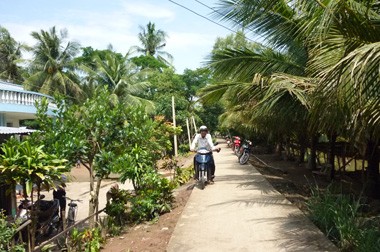(VOVworld) – Soc Trang province has piloted the new rural development program in 22 isolated communes of the Khmer ethnic minority people where the infrastructure remains poor. After three years of implementation, 300 public works have been built to support people develop production, reduce poverty, and imrpove the hamlets.

Inter-hamlet roads have been paved (photo: soctrang.gov.vn) |
Ba Trinh commune in Ke Sach district has completed 11 new rural area criteria. We walked in to hamlet 4 of the Khmer people on paved roads under the shade of orchards laden with fruits on both sides. Vegetable gardens, fish ponds, and rice fields are carefully tended. Villager Duong Thom said agricultural work was less difficult thanks to the results of the new rural development program. Irrigation works were upgraded, paved roads made transportation easier. Fresh water and electricity help the children to study. “I totally support the building new rural areas campaign. With the unity of the administration and the people we have built many rural works to benefit the people.” Thom said.
Xuan Hoa commune has built roads connecting all hamlets. 3.5 km of roads, one suspended bridge, and three concrete bridges were made. Chairman of Xuan Hoa People’s Committee, Nguyen Van Vu, said with the principle of the state and people working together, the villagers donated land and money to expand the roads. They said the government has subsidized them a lot. Now, they don’t have to rely on the subsidy any more and work with the State to build their village.
Truong Khanh commune in Long Phu district, where half of its population are Khmer people, was one of the piloted communes. The administration focused on criteria relating to irrigation, labor structure, and production form. The commune has organized training courses on production techniques, model fields, and cooperatives. Lam Vinh Sang in Truong Hung hamlet joins a cooperative team. “We attend yearly training courses on production techniques. I was introduced to techniques on planting and raising animals. I learned new things and productivity has been improved.”
Deputy Head of Ke Sach district’s Agriculture and Rural Development Office, Vu Ba Quan, said the district had 27,000 hectares of farming land which mainly grew fruit trees and rice. The area in which to grow subsidiary crops has increased from 1,000 to 1,300 hectares, which was part of the rural economic and agricultural restructuring plan. Since the opening of the Nam Song Hau national road, it’s easy for farmers to sell their products.
Over the past 3 years, Soc Trang province invested 500 billion VND in 22 piloted communes to build public works, adopt new varieties of plants and animals, and re-zone farm land. The administration has educated people about the program’s benefits and the villagers have become enthusiastically involved in developing the countryside. Thach Thal is Secretary of Long Phu district’s Party Committee. “The construction of rural works affected people’ land, assets, and crops. In order to obtain the people’s support, the administration has informed them of the benefits to the community. Since they understood, they donated land, labor, and money to work with the state in this campaign.”
Public works have helped Khmer people in Soc Trang to develop production, boost agricultural restructuring, reduce poverty, and create better lives.